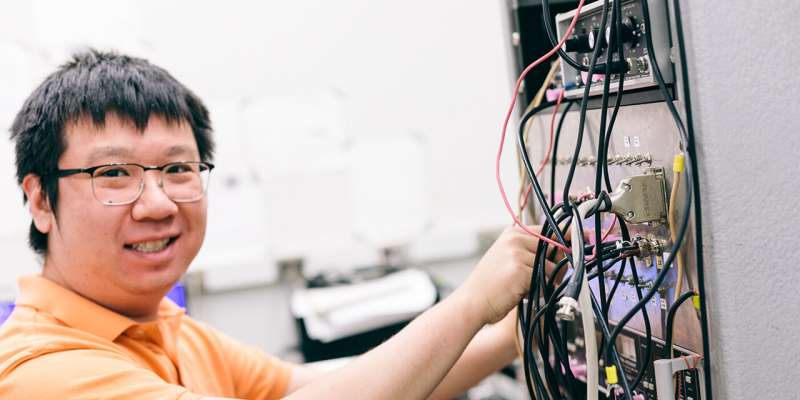This article has been reviewed according to Science X's editorial process and policies. Editors have highlighted the following attributes while ensuring the content's credibility:
fact-checked
trusted source
proofread
Physicists discover a quantum state with a new type of emergent particles: Six-flux composite fermions

If the fractional quantum Hall regime were a series of highways, these highways would have either two or four lanes. The flow of the two-flux or four-flux composite fermions, like automobiles in this two- to four-flux composite fermion traffic scenario, naturally explains the more than 90 fractional quantum Hall states that form in a large variety of host materials. Physicists at Purdue University have recently discovered, though, that fractional quantum Hall regimes are not limited to two-flux or four-flux and have discovered the existence of a new type of emergent particle, which they are calling six-flux composite fermion.
They have recently published their groundbreaking findings in Nature Communications.
Gabor Csathy, professor and head of the Department of Physics and Astronomy at the Purdue University College of Science, along with Ph.D. students Haoyun Huang, Waseem Hussain, and recent Ph.D. graduate Sean Myers, led this discovery from the West Lafayette campus of Purdue. Csathy credits lead author Huang as having conceived and led the measurements, and having written a large part of the manuscript. All the ultra-low-temperature measurements were completed in Csathy's Physics Building lab. His lab conducts research on strongly correlated electron physics, sometimes referred to as topological electron physics.
Weak interactions of electrons are well established, and the behavior is quite predictable. When electrons interact weakly, the electron is commonly considered the natural building block of the entire system. But when the electrons interact strongly, interpreting the systemic behavior by thinking of individual electrons becomes nearly impossible.
"This occurs in very few instances, like in the fractional quantum Hall regime which we study, for example," says Csathy. "To explain fractional quantum Hall states, the composite fermion, a very intuitive fundamental building block, comes in different flavors. They can account for a whole subset of the fractional quantum Hall states. But all the fully developed, (i.e., topologically protected), fractional quantum Hall states could be accounted for by only two types of composite fermions: the two-flux and four-flux composite fermions.
"Here we reported a new fractional quantum Hall state that cannot be explained by any of these previous ideas. Instead, we need to invoke the existence of a new type of emergent particle, the so-called six-flux composite fermions. The discovery of new fractional quantum Hall states is scarce enough. However, the discovery of a new emergent particle in condensed matter physics is truly rare and amazing."
For now, these ideas will be used to expand our understanding of the ordering of the known fractional quantum Hall states into a "periodic table." It is especially notable to this process that the emergent composite fermion particle is unique in that the electron captures six quantized magnetic flux quanta, forming the most intricate composite fermion known to date.
"The numerology of this complicated physics puzzle requires quite some patience," says Haoyun Huang, Csathy's Ph.D. student. "Take the nu=2/3 fractional state as an example. Since 2/3=2/(2*2-1), the nu=2/3 state belongs to the two-flux family. Similarly, for the nu=2/7 fractional state, 2/7=2/(2*4-1), so this state belongs to the four-flux family. In contrast, the fractional states we discovered closely relate to 2/11=2/(2*6-1). Before our work, no fully quantized fractional quantum Hall state was seen that could be associated with six-flux composite fermions. The situation was completely different on the theory front: The existence of these kinds of composite fermions was predicted by Jainendra Jain in his highly influential theory of composite fermions published in 1989. The associated quantization was not observed during these 34 years."
The material used in this study was grown by a Princeton University team led by Loren Pfeiffer. The GaAs semiconductor electrical quality played a huge role in the success of this research. According to Csathy, this Princeton group is leading the world in growing the highest quality GaAs-based materials.
"The GaAs they grow is very special, as the number of imperfections is astonishingly low," he says. "The combination of low disorder and the ultra-low-temperature measurement expertise in the Csathy lab made this project possible. One reason we were measuring these samples is that very recently the Princeton group has significantly improved the quality of the GaAs semiconductor, as measured by the tiny amounts of defects present. These improved samples will, for sure, continue to constitute a playground for new physics."
This exciting discovery is part of ongoing research by Csathy's team. The team continues to push the limits of discovery in their persistent pursuit of topological electron physics.
More information: Haoyun Huang et al, Evidence for Topological Protection Derived from Six-Flux Composite Fermions, Nature Communications (2024). DOI: 10.1038/s41467-024-45860-5
Provided by Purdue University





















